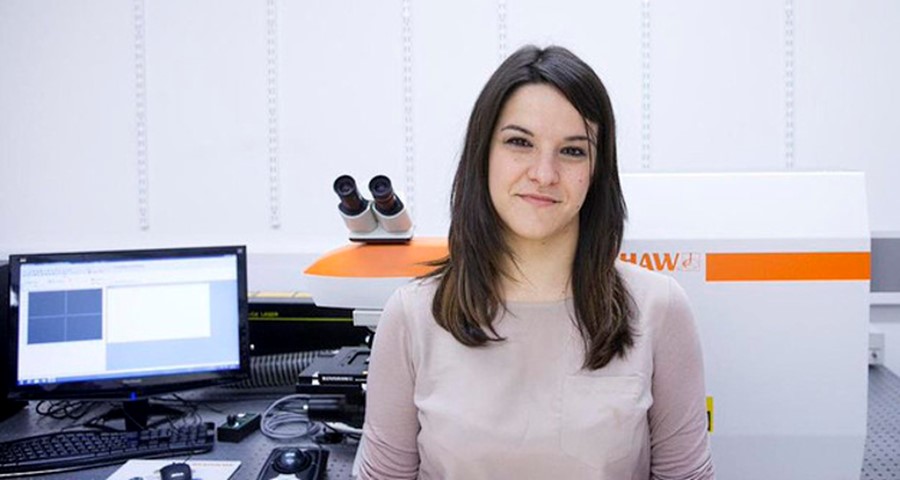Spotlight: Cinzia Casiraghi
The Graphene Flagship's Spotlight series tells the stories behind the research. Cinzia Casiraghi describes her experiences working in academic graphene research, and the challenges she faced in becoming a professor.
In the second interview of the Spotlight series, Cinzia Casiraghi speaks to Enrique Sacristán about her research and her experiences working in academia. Casiraghi is a full professor at the Graphene Flagship partner institute the University of Manchester, UK, leading a research group focused on graphene and related materials (GRMs). Her European Research Council-funded project NOC2D (Nucleation of Organic Crystals onto 2D materials) is a partnering project to the Graphene Flagship.
At the Women in Graphene Career Development Day, held in London on International Women's Day 8 March, Casiraghi gave a talk on her experiences as a female researcher working in graphene, titled Adventures of a Female Scientist in Flatland.
What have been your professional adventures?
The research career is like an iceberg: people see the successes from the top, but not all the hard work, sacrifices, failures and disappointments that lie beneath. In my case, although focused on the field of materials with carbon, I have a fairly interdisciplinary background, and that is not always appreciated in some environments. I obtained my degree in nuclear engineering in Italy in 2001, then I obtained my PhD in electrical engineering from the University of Cambridge, followed by a position as junior group leader (related to physics) at the Free University in Berlin. And I am now full professor at the School of Chemistry at the University of Manchester. Throughout this time there were difficult decisions, like leaving Cambridge, for example, or deciding between important options.
As a researcher, I had two options: to stay in the same department and group, or to establish my own group somewhere else. In the first case, it meant staying in an established laboratory, with nice equipment, in a famous university, where you know everybody, every facility and so on; but it is going to be difficult to gain independence and recognition. In contrast, creating a new group meant starting from scratch: an empty laboratory, looking for facilities, limited money, though with independence and complete freedom. I chose this option in the end, but it was the most difficult moment of my career. Although earning respect as an independent researcher within the community still is one of the most challenging tasks, even with an independent lab.
What are your lines of research?
Currently I have three research lines. One is dedicated to the characterization of GRMs by Raman spectroscopy – a technique used to characterize nanostructures – in particular with the aim of helping the industry to improve the standardization of graphene-based materials. The second is related to the development of inkjet-printable inks made of non-toxic, water-based GRMs, which, like LEGO, can be joined together to create a wide range of flexible devices, such as arrays of light detectors printed on silicon and plastic, as well as logic memories (devices used to store information in form of binary code).
Finally, I have just started the NOC2D project, where I aim at combining the knowledge and skills gained in the first two projects to investigate the nucleation of organic crystals in solution.
What are the objectives of NOC2D?
I would like to use graphene as template in order to understand, and therefore control, the nucleation of organic crystals in liquids. Despite several studies, it is still unclear how molecules in solution start interacting to form a crystal. This process is, however, of fundamental importance in several fields, such as in the food and pharmaceutical industries. My project will mostly focus on graphene, but other GRMs are very interesting because they could be used in applications where graphene is not suitable. Indeed, in nature there are hundreds of layered materials that can be exfoliated to the single-layer level.
What is the situation of women in this field?
I have seen an increase in the number of women working on graphene at the student and postdoctoral level in the last 10 years; however, this increase is not reflected in the number of female group leaders and professors. Indeed, the number of female speakers who get invited to major graphene conferences is very low, typically below 30%. Clearly there is still a lot to do to support and promote the career of women, in particularly in universities. In general, I think there is rather limited visibility for women working in the field of new materials for disruptive technologies.
Some years ago, an inspirational woman, who was the first female Institute Professor at MIT, Millie Dresselhaus, told me: "Family is very important because it will be always there to support you, even in difficult times". Having the support of your partner, your kids, close friends, etc. – people who really care about you – is super important to move forward, also in your professional career.
Read more about Casiraghi's work on inkjet-printable GRMs and heterostructures here.
This is an edited version of an interview by SINC that first appeared on 13 March 2017. http://www.agenciasinc.es/en/Interview/We-print-Lego-stack-devices-with-graphene-and-other-2D-materials-inks

Professor Cinzia Casiraghi




